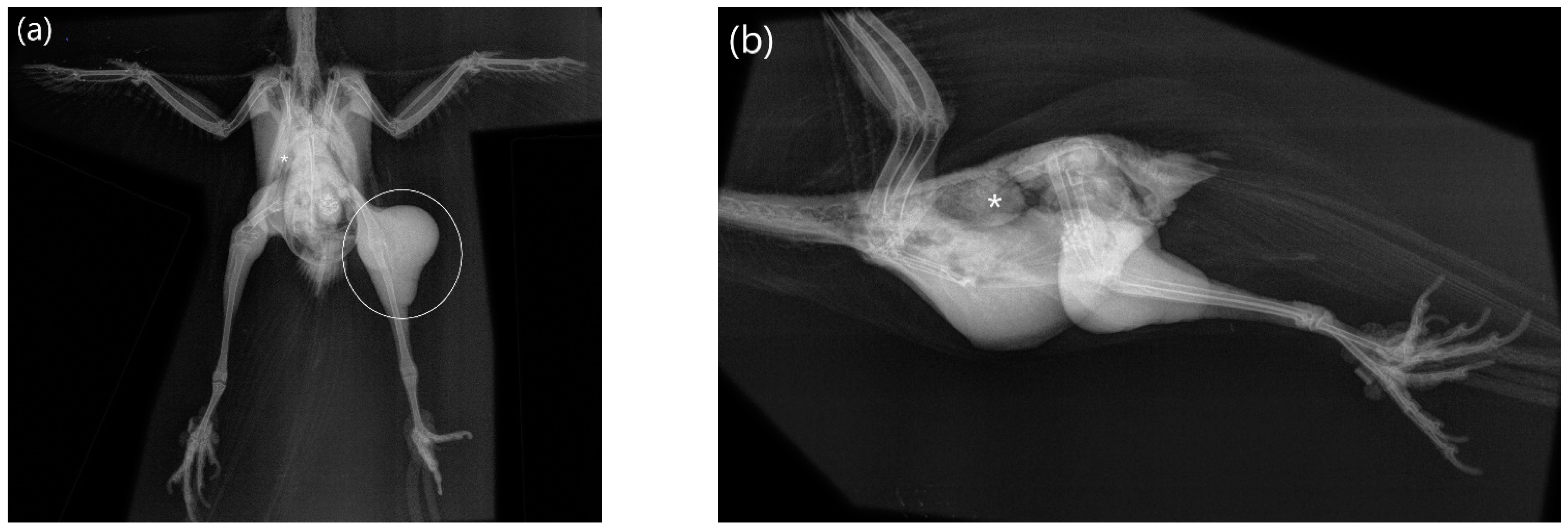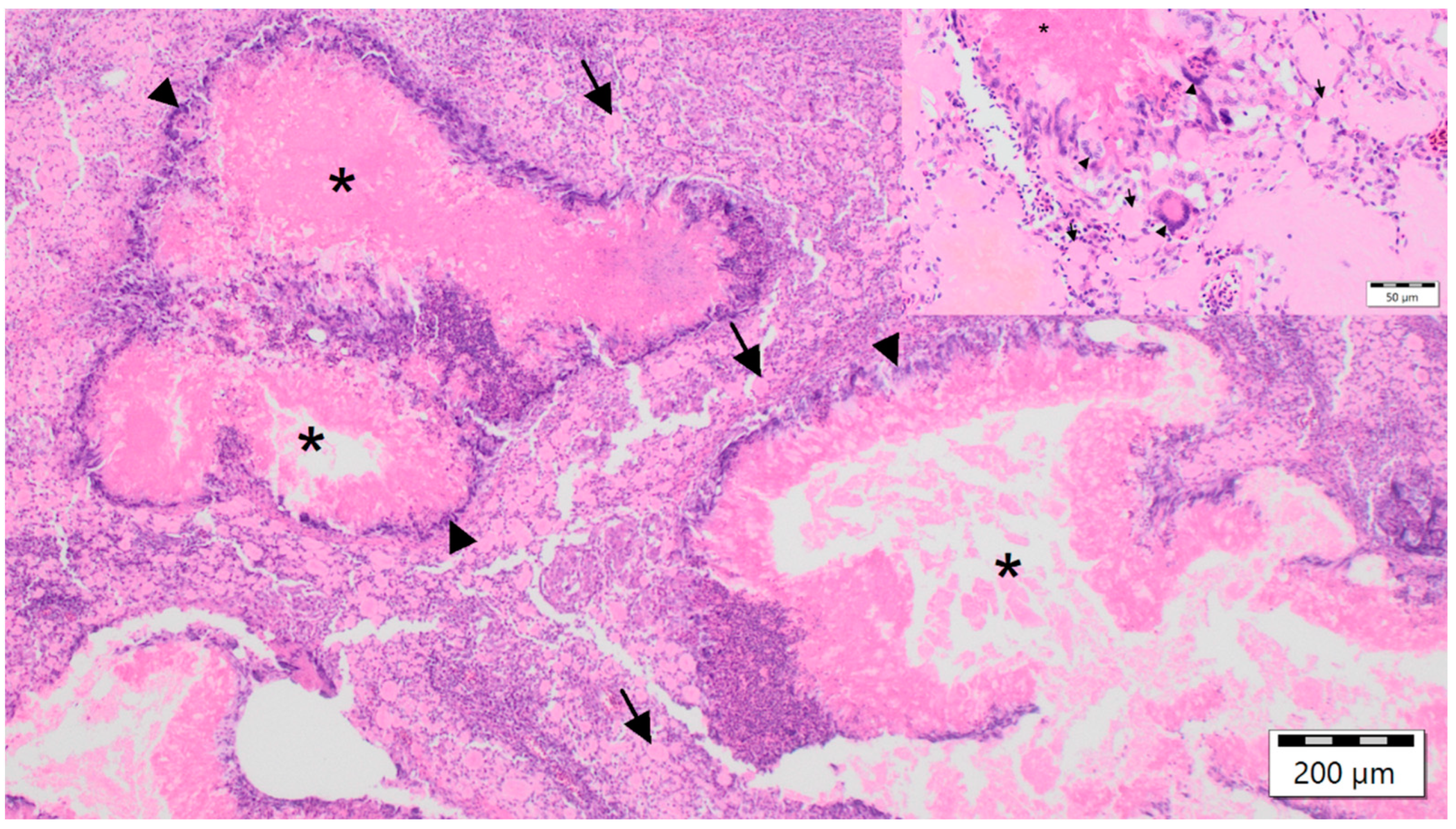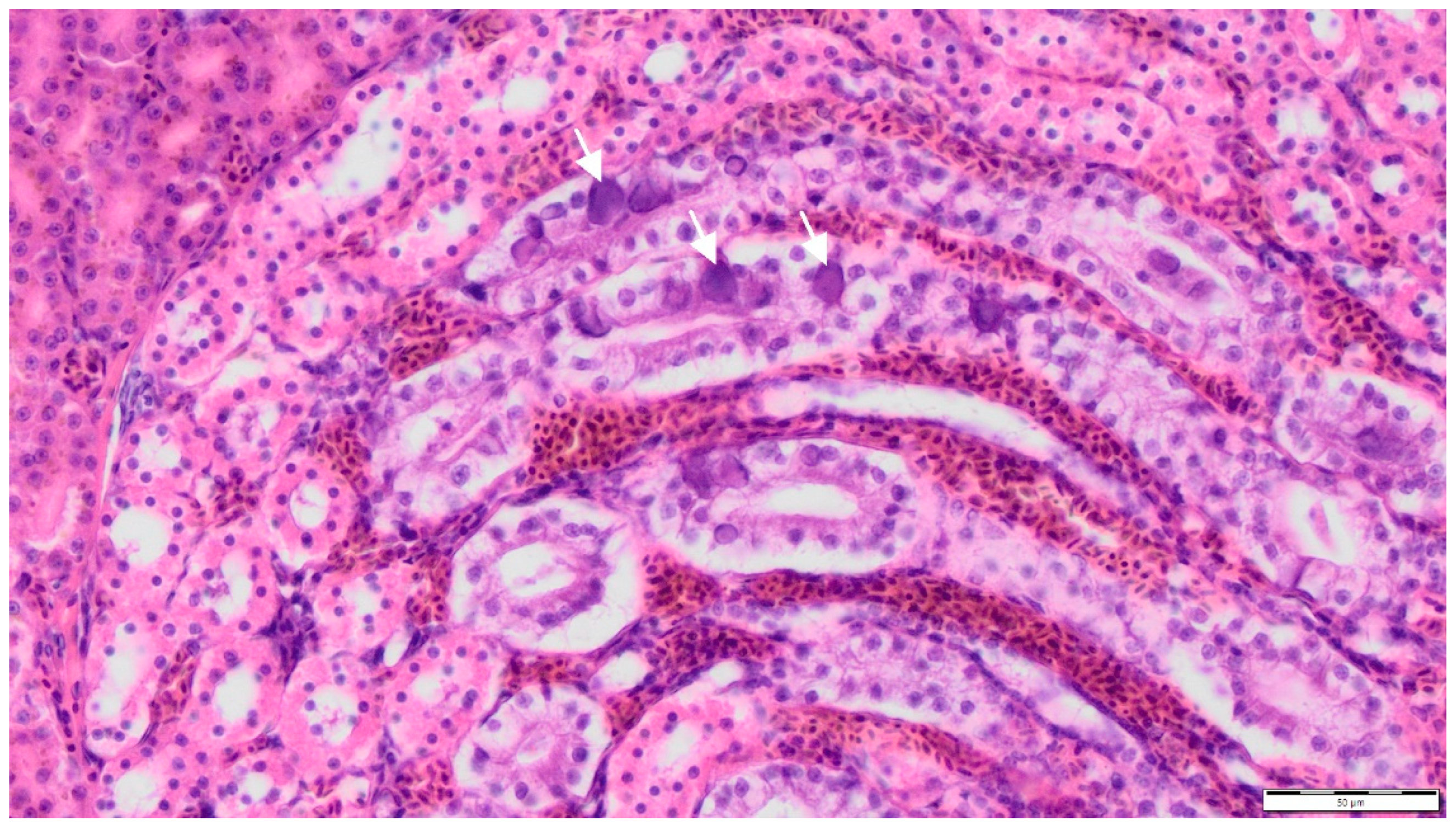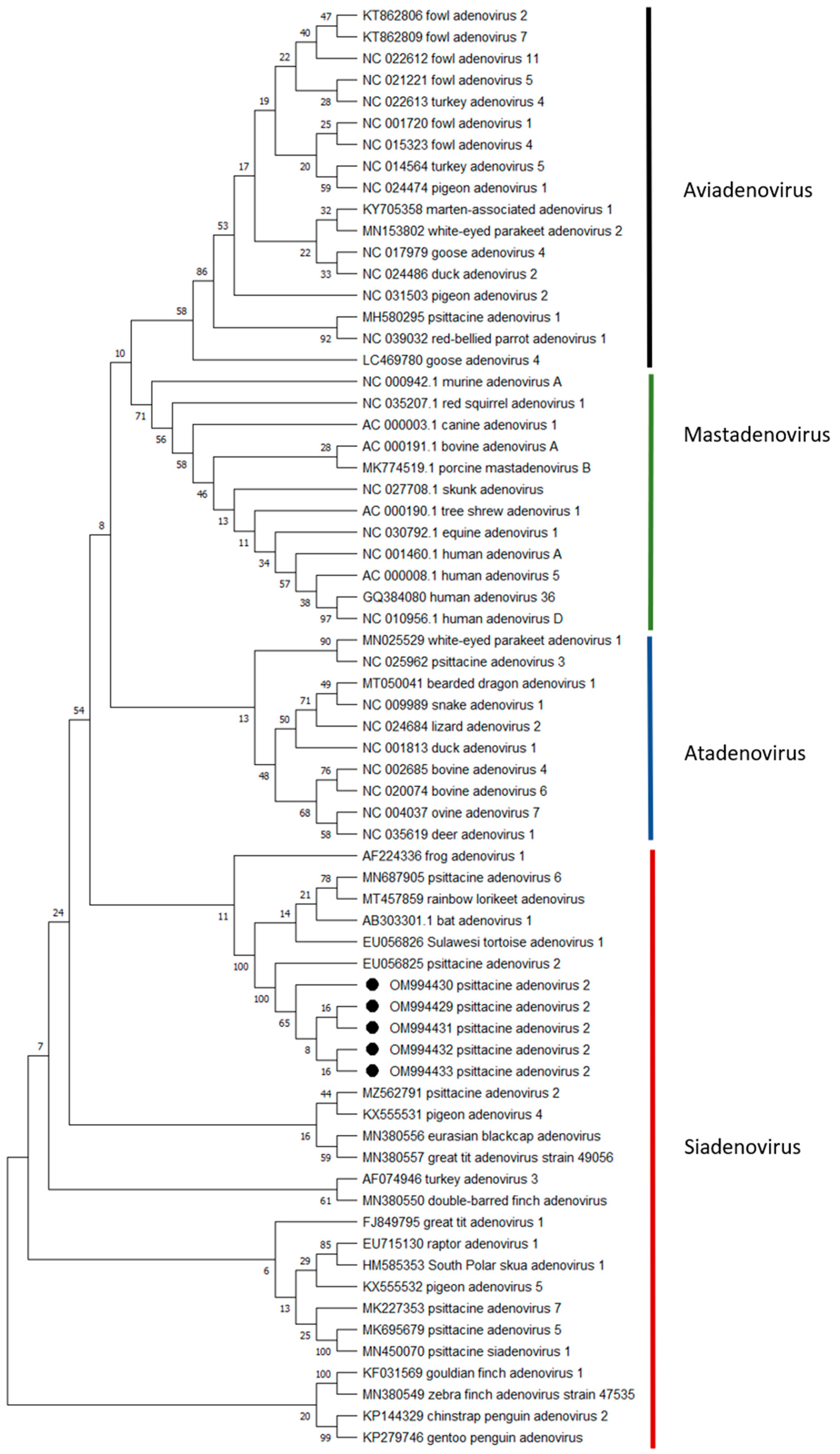Case Series of Disseminated Xanthogranulomatosis in Red-crowned Parakeets (Cyanoramphus novaezelandiae) with Detection of Psittacine Adenovirus 2 (PsAdV-2)
Abstract
:Simple Summary
Abstract
1. Introduction
2. Materials and Methods
3. Results
3.1. Clinical Findings
3.2. Gross Necropsy Findings
3.3. Histopathological Findings
3.4. Virological Results
3.5. Phylogenetic Analysis
4. Discussion
5. Conclusions
Author Contributions
Funding
Institutional Review Board Statement
Informed Consent Statement
Data Availability Statement
Acknowledgments
Conflicts of Interest
References
- Lanteri, G.; Marino, F.; Reale, S.; Vitale, F.; Macrì, F.; Mazzullo, G. Mycobacterium tuberculosis in a Red-crowned Parakeet (Cyanoramphus novaezelandiae). J. Avian Med. Surg. 2011, 25, 40–43. [Google Scholar] [CrossRef]
- Kummerfeld, M. Conjunctival and classical mycobacteriosis in Parakeets and lovebirds. Kleintierpraxis 2009, 54, 365–370. [Google Scholar]
- Ortiz-Catedral, L.; McInnes, K.; Hauber, M.E.; Brunton, D.H. First report of beak and feather disease virus (BFDV) in wild Red-fronted Parakeets (Cyanoramphus novaezelandiae) in New Zealand. Emu-Austral Ornithol. 2009, 109, 244–247. [Google Scholar] [CrossRef]
- Jackson, B.; Varsani, A.; Holyoake, C.; Jakob-Hoff, R.; Robertson, I.; McInnes, K.; Empson, R.; Gray, R.; Nakagawa, K.; Warren, K. Emerging infectious disease or evidence of endemicity? A multi-season study of beak and feather disease virus in wild Red-crowned Parakeets (Cyanoramphus novaezelandiae). Arch. Virol. 2015, 160, 2283–2292. [Google Scholar] [CrossRef] [PubMed]
- Ortiz-Catedral, L.; Prada, D.; Gleeson, D.; Brunton, D.H. Avian malaria in a remnant population of red-fronted Parakeets on Little Barrier Island, New Zealand. N. Z. J. Zool. 2011, 38, 261–268. [Google Scholar] [CrossRef]
- Ortiz-Catedral, L.; Brunton, D.; Stidworthy, M.F.; Elsheikha, H.M.; Pennycott, T.; Schulze, C.; Braun, M.; Wink, M.; Gerlach, H.; Pendl, H.; et al. Haemoproteus minutus is highly virulent for Australasian and South American parrots. Parasit. Vectors 2019, 12, 40. [Google Scholar] [CrossRef]
- Holubová, N.; Sak, B.; Horčičková, M.; Hlásková, L.; Květoňová, D.; Menchaca, S.; McEvoy, J.; Kváč, M. Cryptosporidium avium n. sp. (Apicomplexa: Cryptosporidiidae) in birds. Parasitol. Res. 2016, 115, 2243–2251. [Google Scholar] [CrossRef]
- Ballmann, M.; Vidovszky, M. Detection of broad-host-range psittacine adenovirus (PsAdV-2) in representatives of different parrot species. Magy. Allatorv. Lapja 2013, 135, 78–84. [Google Scholar]
- Benkö, M.; Harrach, B. Molecular evolution of adenoviruses. Curr. Top. Microbiol. Immunol. 2003, 272, 3–35. [Google Scholar] [CrossRef]
- Harrach, B.; Benko, M.; Both, G.; Brown, M.; Davison, A.; Echavarría, M.; Hess, M.; Jones, M.; Kajon, A.; Lehmkuhl, H.; et al. Family Adenoviridae. In Virus Taxonomy: Classification and Nomenclature of Viruses: Ninth Report of the International Committee on Taxonomy of Viruses, 1st ed.; King, A., Adams, M., Carstens, E., Lefkowitz, E., Eds.; Elsevier: San Diego, CA, USA, 2011; pp. 125–141. [Google Scholar]
- Schachner, A.; Matos, M.; Grafl, B.; Hess, M. Fowl adenovirus-induced diseases and strategies for their control—A review on the current global situation. Avian Pathol. 2018, 47, 111–126. [Google Scholar] [CrossRef]
- Yang, N.; McLelland, J.; McLelland, D.J.; Clarke, J.; Woolford, L.; Eden, P.; Phalen, D.N. Psittacid Adenovirus-2 infection in the critically endangered Orange-bellied Parrot (Neophema chrysogastor): A key threatening process or an example of a host-adapted virus? PLoS ONE 2019, 14, e0208674. [Google Scholar] [CrossRef] [PubMed]
- Katoh, H.; Ohya, K.; Kubo, M.; Murata, K.; Yanai, T.; Fukushi, H. A novel budgerigar-adenovirus belonging to group II avian adenovirus of siadenovirus. Virus Res. 2009, 144, 294–297. [Google Scholar] [CrossRef] [PubMed]
- Phalen, D.N.; Agius, J.; Vaz, F.F.; Eden, J.-S.; Setyo, L.C.; Donahoe, S. A survey of a mixed species aviary provides new insights into the pathogenicity, diversity, evolution, host range, and distribution of psittacine and passerine adenoviruses. Avian Pathol. 2019, 48, 437–443. [Google Scholar] [CrossRef] [PubMed]
- Cassmann, E.; Zaffarano, B.; Chen, Q.; Li, G.; Haynes, J. Novel siadenovirus infection in a cockatiel with chronic liver disease. Virus Res. 2019, 263, 164–168. [Google Scholar] [CrossRef]
- Wellehan, J.F.X.; Greenacre, C.B.; Fleming, G.J.; Stetter, M.D.; Childress, A.L.; Terrell, S.P. Siadenovirus infection in two psittacine bird species. Avian Pathol. 2009, 38, 413–417. [Google Scholar] [CrossRef]
- Zadravec, M.; Racnik, J.; Slavec, B.; Ballmann, M.; Marhold, C.; Harrach, B.; Rojs, O.Z. Detection of new adenoviruses in psittacine birds in Slovenia. In Proceedings of the Simpozij Peradarski dani 2011 medunarodnim sudjelovanjem, Sibenik, Croatia, 11–14 May 2011; pp. 131–134. [Google Scholar]
- Surphlis, A.C.; Dill-Okubo, J.A.; Harrach, B.; Waltzek, T.; Subramaniam, K. Genomic characterization of psittacine adenovirus 2, a siadenovirus identified in a moribund African Grey Parrot (Psittacus erithacus). Arch. Virol. 2022, 167, 911–916. [Google Scholar] [CrossRef]
- Dhurandhar, N.V.; Whigham, L.D.; Abbott, D.H.; Schultz-Darken, N.J.; Israel, B.A.; Bradley, S.M.; Kemnitz, J.W.; Allison, D.B.; Atkinson, R.L. Human adenovirus Ad-36 promotes weight gain in male rhesus and marmoset monkeys. J. Nutr. 2002, 132, 3155–3160. [Google Scholar] [CrossRef]
- Dhurandhar, N.V.; Israel, B.A.; Kolesar, J.M.; Mayhew, G.F.; Cook, M.E.; Atkinson, R.L. Increased adiposity in animals due to a human virus. Int. J. Obes. Relat. Metab. Disord. 2000, 24, 989–996. [Google Scholar] [CrossRef]
- Dhurandhar, N.V.; Israel, B.A.; Kolesar, J.M.; Mayhew, G.; Cook, M.E.; Atkinson, R.L. Transmissibility of adenovirus-induced adiposity in a chicken model. Int. J. Obes. Relat. Metab. Disord. 2001, 25, 990–996. [Google Scholar] [CrossRef]
- So, P.-W.; Herlihy, A.H.; Bell, J.D. Adiposity induced by adenovirus 5 inoculation. Int. J. Obes. 2005, 29, 603–606. [Google Scholar] [CrossRef]
- Akheruzzaman, M.; Hegde, V.; Dhurandhar, N.V. Twenty-five years of research about adipogenic adenoviruses: A systematic review. Obes. Rev. 2019, 20, 499–509. [Google Scholar] [CrossRef] [PubMed]
- Dhurandhar, N.V.; Kulkarni, P.; Ajinkya, S.M.; Sherikar, A. Effect of adenovirus infection on adiposity in chicken. Vet. Microbiol. 1992, 31, 101–107. [Google Scholar] [CrossRef]
- Fricke, C.; Schmidt, V.; Cramer, K.; Krautwald-Junghanns, M.-E.; Dorrestein, G.M. Characterization of atherosclerosis by histochemical and immunohistochemical methods in African Grey Parrots (Psittacus erithacus) and Amazon Parrots (Amazona spp.). Avian. Dis. 2009, 53, 466–472. [Google Scholar] [CrossRef]
- Raynor, P.L. Periosseous xanthogranulomatosis in a fledgling great horned owl (Bubo virginianus). J. Avian Med. Surg. 1999, 13, 269–274. [Google Scholar]
- Schmidt, R.E.; Reavill, D.R.; Phalen, D.N. Pathology of Pet and Aviary Birds, 2nd ed.; Wiley Blackwell: Ames, IA, USA, 2015; p. 194. [Google Scholar]
- Donovan, T.A.; Garner, M.M.; Phalen, D.; Reavill, D.; Monette, S.; Le Roux, A.B.; Hanson, M.; Chen, S.; Brown, C.; Echeverri, C.; et al. Disseminated coelomic xanthogranulomatosis in Eclectus Parrots (Eclectus roratus) and budgerigars (Melopsittacus undulatus). Vet. Pathol. 2021, 59, 143–151. [Google Scholar] [CrossRef]
- Hanson, M.E.; Donovan, T.A.; Quesenberry, K.; Dewey, A.; Brown, C.; Chen, S.; Le Roux, A.B. Imaging features of disseminated xanthogranulomatous inflammation in Eclectus Parrots (Eclectus roratus). Vet. Radiol. Ultrasound 2020, 61, 409–416. [Google Scholar] [CrossRef]
- Schmidt, V.; Kümpel, M.; Cramer, K.; Sieg, M.; Harzer, M.; Rückner, A.; Heenemann, K. Tauben-Rotavirus-A-Genotyp-G18P17-assoziierte Krankheitsausbrüche nach Rassetaubenausstellungen in Deutschland—Eine Fallserie. Tierarztl. Prax. Ausg. K Kleintiere. Heimtiere. 2021, 49, 22–27. [Google Scholar] [CrossRef]
- Johne, R.; Enderlein, D.; Nieper, H.; Müller, H. Novel polyomavirus detected in the feces of a chimpanzee by nested broad-spectrum PCR. J. Virol. 2005, 79, 3883–3887. [Google Scholar] [CrossRef] [PubMed]
- Halami, M.Y.; Nieper, H.; Müller, H.; Johne, R. Detection of a novel circovirus in Mute Swans (Cygnus olor) by using nested broad-spectrum PCR. Virus Res. 2008, 132, 208–212. [Google Scholar] [CrossRef]
- Wellehan, J.F.X.; Johnson, A.J.; Harrach, B.; Benkö, M.; Pessier, A.P.; Johnson, C.M.; Garner, M.M.; Childress, A.; Jacobson, E.R. Detection and analysis of six lizard adenoviruses by consensus primer PCR provides further evidence of a reptilian origin for the atadenoviruses. J. Virol. 2004, 78, 13366–13369. [Google Scholar] [CrossRef]
- Latimer, K.S. Oncology. In Avian Medicine: Principles and Applications, 1st ed.; Ritchie, B.W., Harrison, G.J., Harrison, L.R., Eds.; Wingers Publishing Inc.: Lake worth, FL, USA, 1994; pp. 640–672. [Google Scholar]
- Kumar, S.; Stecher, G.; Li, M.; Knyaz, C.; Tamura, K. MEGA X: Molecular Evolutionary Genetics Analysis across computing platforms. Mol. Biol. Evol. 2018, 35, 1547–1549. [Google Scholar] [CrossRef]
- Jukes, T.H.; Cantor, C.R. Evolution of protein molecules. In Mammalian Protein Metabolism, 1st ed.; Munro, H.N., Ed.; Academic Press: New York, NY, USA, 1969; Volume 3, pp. 21–132. [Google Scholar]
- Monks, D.J.; Zsivanovits, H.P.; Cooper, J.E.; Forbes, N.A. Successful treatment of tracheal xanthogranulomatosis in a Red-tailed Hawk (Buteo jamaicensis) by tracheal resection and anastomosis. J. Avian Med. Surg. 2006, 20, 247–252. Available online: https://www.jstor.org/stable/40236555 (accessed on 15 April 2022). [CrossRef]
- Felsenstein, J. Confidence limits on phylogenies: An approach using the bootstrap. Evolution 1985, 39, 783–791. [Google Scholar] [CrossRef]
- Souza, M.J.; Johnstone-McLean, N.S.; Ward, D.; Newkirk, K. Conjunctival xanthoma in a Blue and Gold Macaw (Ara ararauna). Vet. Ophthalmol. 2009, 12, 53–55. [Google Scholar] [CrossRef]
- Laishram, S.; Shimray, R.; Pukhrambam, G.D.; Sarangthem, B.; Sharma, A.B. Xanthogranulomatous inflammatory lesions: A 10-year clinicopathological study in a teaching hospital. Bangladesh J. Med. Sci. 2014, 13, 302–305. [Google Scholar] [CrossRef]
- Karthik, S.; Shobana, B.; Srismitha, S. Clinicopathological study of xanthogranulomatous inflammation. Saudi J. Pathol. Microbiol. 2019, 4, 156–163. [Google Scholar] [CrossRef]
- Shalev, E.; Zuckerman, H.; Rizescu, I. Pelvic inflammatory pseudotumor (xanthogranuloma). Acta Obstet. Gynecol. Scand. 1982, 61, 285–286. [Google Scholar] [CrossRef]
- Orosz, S.E. Clinical avian nutrition. Vet. Clin. North Am. Exot. Anim. Pract. 2014, 17, 397–413. [Google Scholar] [CrossRef]
- Beaufrère, H.; Stark, K.D.; Wood, R.D. Effects of a 0.3% cholesterol diet and a 20% fat diet on plasma lipids and lipoproteins in Monk Parakeet (Myiopsitta monachus). Vet. Clin. Pathol. 2022. [Google Scholar] [CrossRef]
- Beaufrère, H.; Ammersbach, M.; Reavill, D.R.; Garner, M.M.; Heatley, J.J.; Wakamatsu, N.; Nevarez, J.G.; Tully, T.N. Prevalence of and risk factors associated with atherosclerosis in psittacine birds. J. Am. Vet. Med. Assoc. 2013, 242, 1696–1704. [Google Scholar] [CrossRef]
- Hawkins, M.G.; Guzman, D.S.-M.; Beaufrère, H.; Lennox, A.M.; Carpenter, J.W. Birds. In Exotic Animal Formulary, 5th ed.; Carpenter, J.W., Marion, J.C., Eds.; Elsevier: St. Louis, MO, USA, 2018; pp. 167–375. [Google Scholar]
- Beaufrère, H.; Vet, M.; Cray, C.; Ammersbach, M.; Tully, T.N. Association of plasma lipid levels with atherosclerosis prevalence in psittaciformes. J. Avian Med. Surg. 2014, 28, 225–231. [Google Scholar] [CrossRef]
- Jahantigh, M.; Zaeemi, M.; Razmyar, J.; Azizzadeh, M. Plasma Biochemical and Lipid Panel Reference Intervals in Common Mynahs (Acridotheres tristis). J. Avian Med. Surg. 2019, 33, 15–21. [Google Scholar] [CrossRef]
- Beaufrère, H.; Gardhouse, S.; Ammersbach, M. Lipoprotein characterization in Monk Parakeet (Myiopsitta monachus) using gel-permeation high-performance liquid chromatography. Vet. Clin. Pathol. 2020, 49, 417–427. [Google Scholar] [CrossRef]
- Augustine, J.; Venkitakrishnan, R.; Ramachandran, D.; Abraham, L. Xanthogranulomatous pleuritis-An unusual presentation of tuberculosis. Int. J. Mycobacteriol. 2020, 9, 442. [Google Scholar] [CrossRef]
- McFerran, J.B.; Adair, B.M. Avian adenoviruses—A review. Avian Pathol. 1977, 6, 189–217. [Google Scholar] [CrossRef]
- Yuan, F.; Hou, L.; Wei, L.; Quan, R.; Wang, J.; Liu, H.; Liu, J. Fowl Adenovirus serotype 4 induces hepatic steatosis via activation of liver X receptor-α. J. Virol. 2021, 95. [Google Scholar] [CrossRef]
- Karamese, M.; Altoparlak, U.; Turgut, A.; Aydogdu, S.; Karamese, S.A. The relationship between adenovirus-36 seropositivity, obesity and metabolic profile in Turkish children and adults. Epidemiol. Infect. 2015, 143, 3550–3556. [Google Scholar] [CrossRef]
- Ponterio, E.; Gnessi, L. Adenovirus 36 and obesity: An overview. Viruses 2015, 7, 3719–3740. [Google Scholar] [CrossRef]
- Cakmakliogullari, E.K.; Sanlidag, T.; Ersoy, B.; Akcali, S.; Var, A.; Cicek, C. Are human adenovirus-5 and 36 associated with obesity in children? J. Investig. Med. 2014, 62, 821–824. [Google Scholar] [CrossRef]
- Gabbert, C.; Donohue, M.; Arnold, J.; Schwimmer, J.B. Adenovirus 36 and obesity in children and adolescents. Pediatrics 2010, 126, 721–726. [Google Scholar] [CrossRef]
- Esposito, S.; Preti, V.; Consolo, S.; Nazzari, E.; Principi, N. Adenovirus 36 infection and obesity. J. Clin. Virol. 2012, 55, 95–100. [Google Scholar] [CrossRef] [PubMed]
- Na, H.-N.; Hong, Y.-M.; Kim, J.; Kim, H.-K.; Jo, I.; Nam, J.-H. Association between human adenovirus-36 and lipid disorders in Korean schoolchildren. Int. J. Obes. 2010, 34, 89–93. [Google Scholar] [CrossRef] [PubMed]
- Grafl, B.; Aigner, F.; Liebhart, D.; Marek, A.; Prokofieva, I.; Bachmeier, J.; Hess, M. Vertical transmission and clinical signs in broiler breeders and broilers experiencing adenoviral gizzard erosion. Avian Pathol. 2012, 41, 599–604. [Google Scholar] [CrossRef] [PubMed]





| Case No. | Age in Months | Weight in g | Body Condition | Gender | Location of Xanthogranulomas | Additional Findings and Diagnoses | ||||
|---|---|---|---|---|---|---|---|---|---|---|
| Fa | Lu | Li | Sp | Ot | ||||||
| 1 | 24 | 73 | 3/5 | Male | + | + | + | − | + | Overgrown beak and claws, feather loss, hepatomegaly, splenic and renal haemosiderin, Procnemidocoptes janssensi |
| 2 | 36 | 72 | 3/5 | Female | + | + | + | − | + | − |
| 3 a | 10 | 58 | 2/5 | Male | − | − | − | − | − | Overgrown beak and claws, hepatosplenomegaly, intravasal coagulopathy, acute necrotising splenohepatitis with amphophilic intranuclear inclusion bodies inside reticular cells and hepatocytes, lymphocytic depletion of the lymph follicles of the spleen, acute catarrhal duodenitis, subacute ulcerative proventriculitis and fibrinous fungal pneumonia |
| 4 a | 12 | 79 | 3/5 | Male | − | − | + | + | + | − |
| 5 b | 48 | 69 | 4/5 | Male | − | − | − | − | − | Overgrown beak and claws, steatosis hepatis |
| 6 b | 30 | 49 | 1/5 | Female | − | + | − | − | + | Subacute fibrinous conjunctivitis with isolation of Pseudomonas aeruginosa |
Publisher’s Note: MDPI stays neutral with regard to jurisdictional claims in published maps and institutional affiliations. |
© 2022 by the authors. Licensee MDPI, Basel, Switzerland. This article is an open access article distributed under the terms and conditions of the Creative Commons Attribution (CC BY) license (https://creativecommons.org/licenses/by/4.0/).
Share and Cite
Konicek, C.; Heenemann, K.; Cramer, K.; Vahlenkamp, T.W.; Schmidt, V. Case Series of Disseminated Xanthogranulomatosis in Red-crowned Parakeets (Cyanoramphus novaezelandiae) with Detection of Psittacine Adenovirus 2 (PsAdV-2). Animals 2022, 12, 2316. https://doi.org/10.3390/ani12182316
Konicek C, Heenemann K, Cramer K, Vahlenkamp TW, Schmidt V. Case Series of Disseminated Xanthogranulomatosis in Red-crowned Parakeets (Cyanoramphus novaezelandiae) with Detection of Psittacine Adenovirus 2 (PsAdV-2). Animals. 2022; 12(18):2316. https://doi.org/10.3390/ani12182316
Chicago/Turabian StyleKonicek, Cornelia, Kristin Heenemann, Kerstin Cramer, Thomas W. Vahlenkamp, and Volker Schmidt. 2022. "Case Series of Disseminated Xanthogranulomatosis in Red-crowned Parakeets (Cyanoramphus novaezelandiae) with Detection of Psittacine Adenovirus 2 (PsAdV-2)" Animals 12, no. 18: 2316. https://doi.org/10.3390/ani12182316
APA StyleKonicek, C., Heenemann, K., Cramer, K., Vahlenkamp, T. W., & Schmidt, V. (2022). Case Series of Disseminated Xanthogranulomatosis in Red-crowned Parakeets (Cyanoramphus novaezelandiae) with Detection of Psittacine Adenovirus 2 (PsAdV-2). Animals, 12(18), 2316. https://doi.org/10.3390/ani12182316





